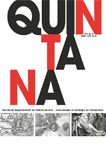Ao publicar en Quintana, o/o autor/a-os/os autores/as cede/n todos os dereitos de explotación do seu artigo (incluíndo distribución, comunicación pública, reprodución e transformación) á Universidade de Santiago de Compostela, que, coas condicións e limitacións dispostas pola lexislación en materia de propiedade intelectual, é a titular do copyright e, por tanto, de todos os dereitos patrimoniais expresados, retendo o/o autor/a-os/os autores/as todos os dereitos morais que por lei lle corresponde/n (art. 14 TRLPI).
Sen prexuízo do anterior, e agás indicación contraria, todos os contidos distribúense en acceso aberto baixo unha licenza internacional Creative Commons BY-NC-ND 4.0. Calquera forma de reprodución, distribución, comunicación pública ou transformación desta obra non incluída na licenza Creative Commons BY-NC-ND 4.0 só pode ser realizada coa autorización expresa do titular do copyright, non sendo excepción prevista pola lei. Pode acceder Vde. ao texto completo da licenza nesta ligazón: https://creativecommons.org/licenses/by-nc-nd/4.0/deed.gl






